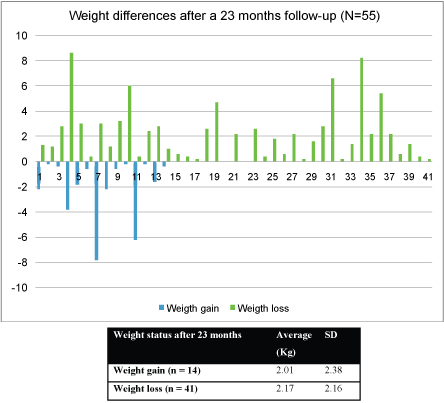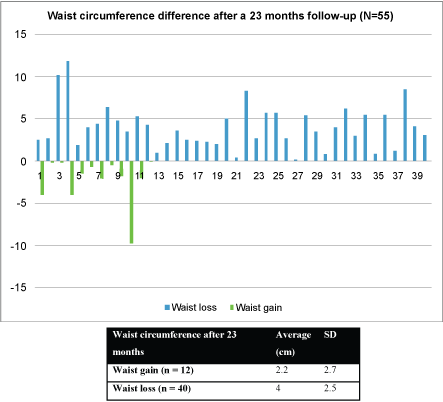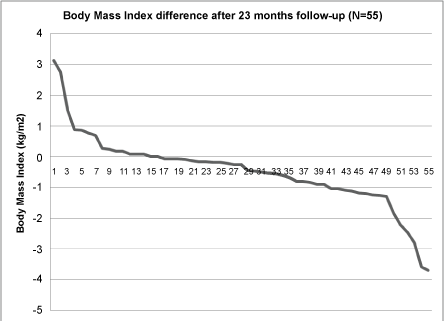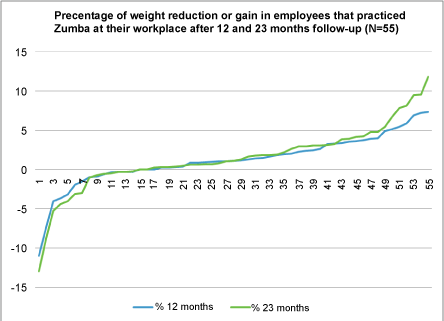Mexico has an elevated prevalence of obesity. Advisors had proposed nationwide programs to increment physical activity. Exercise in the workplace had a beneficial impact in anthropometric measures and BMI. Zumba® can improve those measurements and benefit workers health. Our main objective is to evaluate the impact of a Zumba® fitness class in the health of workers.
A 23 months follow-up study was carried out. 50 minutes Zumba® Class was imparted to hospital employees. Follow-up measures were documented in three different moments: (i) At the beginning of the program (M0), (ii) After 12 months (M1), and (iii) After 23 months (M2). We documented: (i) Age (years), (ii) Weight (kilograms), (iii) Height (centimeters), (iv) Waist circumference (centimeters), (v) Body Mass Index (kilograms per square meter) (BMI), (vi) Waist to Height Ratio (WHtR), (vi) Program adherence, and (vii) Presence of injuries.
55 subjects finished follow-up. Weight, waist circumference, BMI and WHtR had statistically significant reduction after one year. This reduction was maintained after 23 months.
This study demonstrates the need to incorporate an effective follow-up nutritional program to physical activity interventions at the workplace. Additional research is needed in order to improve workers health.
Mexico has an elevated prevalence of obesity [1]. According to worldwide statistics this country is ranked as the first place in children obesity and as the second place in adult obesity [2]. It has been documented that "hospital workers" in Mexico: (i) Have a mean Body Mass Index (BMI) of 27.3 (kilograms per square meter) [3], and that (ii) The prevalence of obesity increased from 13% to 17% during a 2 year follow-up [4]. Obesity is a serious problem among this specific population.
The impact of obesity on health had been widely studied. Diverse systematic reviews and meta-analysis reported that a Body Mass Index (BMI) above 40 (kilograms per square meter) correlates positively with an increase in: (i) Cardiovascular risk, (ii) Diabetes mellitus, (iii) Hypertension, (iv) Dyslipidemia, (v) Cancer, (vi) Pneumopathies, (vii) Biomechanical and axial abnormalities, (viii) Locomotive disorders, (ix) Depression, and (x) Dietary abnormal behaviors. For those reasons government medical advisors in Mexico had proposed the inclusion of free programs to promote and encourage physical activity [5-7].
The benefits of exercise on health had been extensively documented. There is relevant evidence about the positive outcomes of exercise programs at the workplace. Meta-analytical reports of those programs had found a beneficial impact on blood lipids, anthropometric measures and BMI. There is also evidence that demonstrate that exercise at the workplace programs may promote: (i) A weight reduction, (ii) A decrease in the percentage of body fat, (iii) A decrease in absenteeism, and (iv) A reduction in work related stress [8,9].
Hospital workers in Mexico have an elevated metabolic risk due sedentarism and obesity. They have also high levels of work related stress. A program to promote physical activation might be beneficial to this population [10]. We identified soccer and Zumba® as workplace exercise programs in studies that include hospital employees.
Zumba® is a fitness program that is practice worldwide. This activity promote an energy expenditure that ranges from 6.6 to 9.5 Kcal•min-1. According to diverse reports Zumba® training may: (i) Reduce body weight, (ii) Decrease the total body fat mass and fat percentage, (iii) Improve BMI, (iv) Improve the Quality of Life Index, (v) Improve the six minute walking test (neuromuscular function), (vi) Improve Maximal Oxygen Uptake (VO2max), (vii) Reduce in the fasting triglycerides, (viii) Improve cardiovascular function, (ix) Reduced the pain intensity and duration of pain in the neck-shoulder region, (x) Improve self-perception of physical strength and muscular development and (xi) Decrease the levels of inflammatory markers such as interleukin-6 and White Blood Cell (WBC) count [11-15].
Since hospital workers present obesity, an increase in metabolic risk, and work related stress; and a physical activation program, such as Zumba®, may improve those variables; we designed a study with the objective to assess the impact of a Zumba® Fitness 50 minutes class at the workplace in hospital employees during a 23 months follow-up.
Recruitment of participants was achieved by the placement of posters inviting hospital workers to a free 50 minutes Zumba® Fitness Class at the workplace. Workers over 18 years of any gender were included in this study. Workers with a health condition that contraindicate any kind of exercise and those with a confirmed pregnancy were excluded. Workers that did not continued the follow-up period were mobilized from the study.
The classes took place inside the hospital from Monday to Thursday and were instructed by a licensed Zumba® Fitness Instructor. We documented the following dataof each participant at the first class (M0): (i) Age (years), (ii) Weight (kilograms), (iii) Height (centimeters), (iv) Waist circumference (centimeters), (v) Body Mass Index (BMI), (vi) Waist To Height Ratio (WHtR), and (vii) Presence of injuries.
After 12 months follow-up (M1), and after 23 months follow-up we registered (M2): (i) Weight (kilograms), (ii) Waist circumference (centimeters), (iii) Body Mass Index (BMI), (iv) Waist To Height Ratio (WHtR), and (vi) Presence of injuries. The data form these two moments were compared to the first Measurement (M0).
The analysis of the collected data included descriptive statistics and measures of central tendency. A two-way ANOVA with repeated measures was used to determine the effect of the Zumba® Class in the three different period of time. For parametric and no-parametric test a P value < 0.05 was considered statistically significant. Data analysis was performed with statistical software (SPSS version 15; SPSS, Chicago, IL, USA).
The "Health and Exercise Program" that hosted the Zumba® Fitness class lasted 23 months. Over that period of time one hundred employees took classes but only 55 (55%) completed the 23 month follow-up. The identified causes that were related for an uncomplete follow-up were: (i) Change of work schedule (18/45, 40%), (ii) Change of labor responsibilities (18/45, 40%), (iii) Interest in other kind of group exercises (4/45, 9%), (iv) Injuries (plantar fasciitis in all three subjects) (3/45, 7%), and unidentified (2/45, 4%). The results of the 55 subjects who completed the follow-up were analyzed.
Of the 55 subjects who completed the follow-up: (i) 96% were woman (53 subjects), (ii) Had an average age of 46-years-old (CI 95%: 44 to 48 yo, Mode 47, SD: 9), (iii) Had an average height of 155.6 centimeters (CI 95%: 154.2 to 157.2, Mode 156, SD: 5.6), and (iv) Attended an average of 3 Zumba® Fitness classes per week (CI 95%: 2 to 6, Mode 3, SD: 1).
Nine out of ten employees stayed in the Zumba® Fitness program after 12 months, and 7 out of 10 stayed in the program after 23 months.
Weight had an average value of 69.3 kilograms in M0 (SD: 10), 68.4 kilograms in M1 (SD: 10), and 68.2 kilograms in M2 (SD: 10). Intra-subjects effect test was statistically significant (p = 0.004). A loss of one kilogram was observed between M0 and M1, and between M0 and M2.
However, after 23 months, we observed a weight reduction in 41 subjects (74%) and a weight gain in 14 subjects (26%) (Chi-square, p = 0.000). Those who lose weight lost an average of 2.17 kilograms (SD: 2.16), on the contrary those who gain weight gained 2.01 kilograms (SD: 2.38). It is important to mention that none of the study subject had any kind of diet or nutritional plan for weight reduction (Figure 1).
 Figure 1: The figure shows each subject weight gain or loss. An average loss of 2.17 kilogram was observed after 23 months of Zumba® Classes in 41 subjects. 24% of the subjects gained weight as it is shown in the table. We found statistic differences between those who lose weight and those who gained weight (Chi-square, p = 0.000). View Figure 1
Figure 1: The figure shows each subject weight gain or loss. An average loss of 2.17 kilogram was observed after 23 months of Zumba® Classes in 41 subjects. 24% of the subjects gained weight as it is shown in the table. We found statistic differences between those who lose weight and those who gained weight (Chi-square, p = 0.000). View Figure 1
Waist circumference had an average value of 91.7 centimeters in M0 (SD: 9.5), 89.8 centimeters in M1 (SD: 9.5), and 89.3 centimeters in M0 (SD: 9.9). Intra-subjects effect test was statistically significant (p = 0.000). A reduction of 1.9 centimeters in waist circumference was observed between M0 and M1, and a reduction of 2.4 centimeters in waist circumference was observed between M0 and M2.
We observed an increase of waist circumference in 12 subjects (22%), 3 subjects remained without any change in their waist circumference (5%), and 40 subjects presented a reduction in their waist circumference (73%). Statistical differences were found between those who presented a reduction in their waist circumference and those who presented an increase in their waist circumference (Chi-square, p = 0.05). The mean reduction in waist circumference was 4 centimeters (SD: 2.5), and mean increase in waist circumference was 2.2 centimeters (SD: 2.7) (Figure 2).
 Figure 2: The figure shows each subject waist gain or loss. An average loss of 4 centimeter was observed after 23 months of Zumba® Classes in 40 subjects. 22% of the subjects gained centimeters as it is shown in the table. Three subjects had not any change in their waist circumference. We found statistic differences between those who lose waist centimeters and those who gained waist centimeters (Chi-square, p = 0.000). View Figure 2
Figure 2: The figure shows each subject waist gain or loss. An average loss of 4 centimeter was observed after 23 months of Zumba® Classes in 40 subjects. 22% of the subjects gained centimeters as it is shown in the table. Three subjects had not any change in their waist circumference. We found statistic differences between those who lose waist centimeters and those who gained waist centimeters (Chi-square, p = 0.000). View Figure 2
BMI during had an average value of 28.6 (kilograms per square meter) in M0 (SD: 4.5), 28.2 (kilograms per square meter) in M1 (SD 4.2), and 28.1 (kilograms per square meter) in M2 (± 4.3). Intra-subjects effect test was statistically significant (p = 0.004).
14 subjects had an increase in their BMI (25%), two did not present any change (5%), and 39 shown a reduction in their BMI (70%). There were significant statistical differences between those who increase their BMI and those with a reduction in their BMI (Chi-square, p = 0.000). BMI reduction shown a mean value of 0.94 (kilograms per square meter) (SD: 0.91). BMI increase shown a mean value of 0.83 (kilograms per square meter) (SD: 0.98) (Figure 3).
 Figure 3: The figure shows each subject BMI. 14 subjects had an increase in their BMI (25%), two did not present any change (5%), and 39 shown a reduction in their BMI (70%). BMI reduction shown a mean value of 0.94 (kilograms per square meter) (SD: 0.91). BMI increase shown a mean value of 0.83 (kilograms per square meter) (SD: 0.98). View Figure 3
Figure 3: The figure shows each subject BMI. 14 subjects had an increase in their BMI (25%), two did not present any change (5%), and 39 shown a reduction in their BMI (70%). BMI reduction shown a mean value of 0.94 (kilograms per square meter) (SD: 0.91). BMI increase shown a mean value of 0.83 (kilograms per square meter) (SD: 0.98). View Figure 3
WHtR had an average value of 0.58 in M0 (SD: 0.06), 0.57 in M1 (SD: 0.06), and 0.57 in M2 (SD: 0.06). Intra-subjects effect test was statistically significant (p = 0.000).
A systematic review indicated that Zumba® fitness could be considered as a physical activity with positive effects in body weight and other anthropometric measurements [11]. Our study consisted in a 23 months follow-up. This follow-up period is longer than those reported in the studies that we encountered in our bibliographical research. As reported by Vendramin and colleague, we also observed a positive effect in body weight, waist circumference, BMI, and WHtR. All of those measurements presented a statistically significant reduction in our study [11].
Khera and colleagues documented in a meta-analytical review the impact of weight reduction with different medications when compared with placebo. They reported that orlistat presented a mean reduction of 2.6 kilograms among overweight and obese adults [16]. In our study we observed that 74% of the subjects lost weight (41/55), and that weight reduction had a mean value of 2.17 kilograms. Our findings suggest that weight reduction with a Zumba® Fitness program is similar that the one observed with orlistat.
As mentioned above, the 41 subjects who lost weight in our study lost an average of 2.17 kilograms, however 22% of those individuals lost more than 3 kilograms (9/41). 5 of those 9 persons lost more than 5 kilograms (56%). 2 of those 9 persons lost more than 8 kilograms (22%). According to Khera and colleagues (2016), lorcaserin presented a mean reduction of 3.2 kilograms, naltrexone-bupropion and liraglutide shown a mean reduction of 5 and 5.3 kilograms respectively, and phentermine-topiramate exhibit a mean reduction of 8.8 kilograms. That meta-analysis identified that withdrawal due adverse events was statistically significant [16]. Our findings suggest that a Zumba® Fitness program may work as good as those medications without their adverse effects.
The report of Khera and colleagues identified a 5% weight loss at 52 weeks when medications were compared to placebo [16]. In our study, 17% (4/41) of those who lose weight lost 5% of their initial body weight during the same period of time (52 weeks). By the end of the second year 22% (9/41) of those who lose weight lost 5% of their initial body weight (Figure 4). Our study suggest that a Zumba® Fitness program without any nutritional recommendation or plan will be as effective of weight reduction medication in only 2 of every 10 students.
 Figure 4: The figure shows each subject percentage in weight reduction or gain. Percentages were obtained when initial weight was compared to the measure after 12 months and to the measure after 23 months. Percentage in weight reduction is presented as a positive value and gain as a negative value. 17% (4/41) of those who lose weight lost 5% of their initial body weight after 12 months follow-up. 22% (9/41) of those who lose weight lost 5% of their initial body after 23 months follow-up. View Figure 4
Figure 4: The figure shows each subject percentage in weight reduction or gain. Percentages were obtained when initial weight was compared to the measure after 12 months and to the measure after 23 months. Percentage in weight reduction is presented as a positive value and gain as a negative value. 17% (4/41) of those who lose weight lost 5% of their initial body weight after 12 months follow-up. 22% (9/41) of those who lose weight lost 5% of their initial body after 23 months follow-up. View Figure 4
A systematic review by Johns and colleagues (2016), shown that uncontrolled evaluations of weight loss programs, in the absence of any intervention, would present a reduction of one kilogram or less at the end of the first year [17]. Our results were obtained from health employees without any nutritional plan or diet. Despite we observed a 2 kilogram reduction in 74% of the subjects only 7% (4 of the 55 subjects) had a 5% reduction in body weight after the first 12 months. This observation demonstrates the necessity to include nutritional programs to exercise initiatives at the workplace.
WHtR is a measurement easy to obtain and inexpensive. This adiposity index reflects central obesity and might be a useful screening measurement to identify individuals at high risk for diabetes mellitus. The cut-off WHtR value for diabetes development risk is set at 0.51 [18]. A WHtR value of 0.5 combined with a BMI < 27 (kilograms per square meter) may predict a hypertensive risk [19].
In our study 89% (49/55) of the subjects were in risk to develop diabetes mellitus. That number decreased to 82% (45/55) after 23 months of regular exercise [diabetes mellitus risk reduction of 7%]. 82% (45/55) had risk to develop hypertension at the beginning of the study. That number decreased to 64% (35/55) after 23 months of regular exercise [hypertension risk reduction of 18%]. These observations propose that Zumba® Fitness may reduce the risk to develop diabetes or hypertension.
Anthropometric measures (such as BMI and WHtR) might be an optimal tool to evaluate a "combined nutritional and physical activity workplace programs". An isolated "physical activity program" might not be able to improve the risks associated to sedentarism in working populations. "Combined Nutritional and Exercise Programs" at the workplace have not been studied in Mexico. This is an area of opportunity for research and development. Zumba® fitness classes had shown in a systematic review psychological and social benefits [9]. These variables were not investigated in our study and may be an area of opportunity for future research.
In memory of our beloved friend Federico Torres-Puente. We would like to thank the authorities of the Instituto Nacional de Ciencias Médicas y Nutrición Salvador Zubirán for their support. Our sincere gratitude to the workers that participate in this study, thank you for your enthusiasm and willingness.
The present study had not any grant or financial aid. Zumba® is a registered trademark of Zumba Fitness, LLC, used under license. The authors do not declare any further conflict of interest.